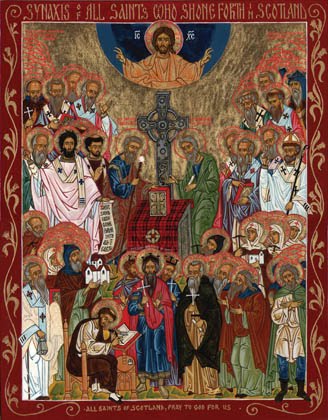
Άγιος Comgall, Ηγούμενος 8,000 Μοναχών στο Bangor Ιρλανδίας († 603)
Ἦτο υἱός στρατιώτου,προοριζόμενος και ὁ Ἱδιος ὑπό του πατρός του διά τό επάγγελμα τοῦτο ,το ὁποῖον πιθανῶς ἠκολούθησεν ἐπὶ βραχύ διάστημα.Ἐσπούδασεν εἰς τήν σχολήν τοῦ ἁγίου Finian και ἐξῆλθεν ἀπό τό φυτώριον ἐκεῖνο τῆς ἁγιότητος λίαν κατηρτισμένος.Ἵδρυσε τήν περίφημον μονήν τοῦ Bangor ,ᾑ ὁποία ὑπήρξεν ἡ πολυπληθεστέρα καί ἐνδοξοτέρα τῇς Ἰρλανδίας ὃπως καί ᾑ συνώνυμος μονή τῇς Βορείου Οὐαλίας ὑπήρξεν ᾑ σπουδαιοτέρα τῶν ᾀρχαίων Βρεταννῶν.Λέγεται ὅτι ἐπι τῶν ἡμερῶν του ἐγκατεβίουν εἰς τήν μονήν τοῦ Bangor περί τάς 3.000 μοναχῶν.
Ἐφήρμοσε τούς μοναχικούς κανόνας τοῦ Μεγάλου Βασιλείου,ὅπως καί πολλοί ἂλλοι ἱδρυταί μονῷν,οἵτινες ἀπέβλεπον ὡς πρός πρότυπα εἰς τούς ᾀνατολικούς μοναχούς.Οἱ κανονισμοί οὗτοι μετεφέρθησαν διά τῶν μαθητῷν τοῦ ἁγίου Κολουμπάνου,εἰς Βρεττάνην,Γαλλίαν,Γερμανίαν καί Ἰταλίαν.Πολλοί ἐκ τῶν μαθητῶν τοῦ Gomgall προήχθησαν εἰς ἐπισκοπους και ᾑγουμένους καί συγκαταλέγονται μετά τῶν ἁγίων.Ἐκ τῇς μονῆς του,ἡ ὁποία κατεστράφη ὑπο τῶν Δανῶν τό 823,προέρχεται τό περίφημον: Antiphonary of Bangor κείμενον εἰς τήν ᾈμβροσιανήν βιβλιοθήκην του Μιλάνου.Τοῦτο εἶναι ἓνα σπάνιον σύγγραμμα ἐκ τοῦ οποίου ᾀντλοῦμεν πληροφορίας περί τῇς λειτουργικῇς πράξεως τῆς ἐποχῆς ἐκείνης εἱς τάς Βρεττανικάς Νήσους.ᾈπέθανε το 602 κάι τιμᾷται τήν 10ην Μαῒου.
Saint Comgall, an early Irish saint, was the founder and abbot of the great Irish monastery at Bangor (located in present day Northern Ireland), who flourished in the sixth century.
Life
The year of his birth is uncertain, but according to the testimony of the Irish annals it must be placed between 510 and 520; his death is said to have occurred in 602 (Annals of Tigernach and Chronicon Scotorum), or 597 (Annals of Innisfallen). He was born in Dál nAraidi (Dalaradia) in Ulster near the place now known as Magheramorne in the present County Antrim.
He seems to have served first as a soldier, and on his release from military service he is said to have studied at Clonard with St. Finnian, and at Clonmacnoise with St. Ciaran, who died in 549. We next find him in Ulster in an island on Lough Erne accompanied by a few friends following a very severe form of monastic life. He intended to go to Britain, but was dissuaded from this step by Lugidius, the bishop who ordained him, at whose advice he remained in Ireland and set himself to spread the monastic life throughout the country. The most famous of the Comgall is Bangor, situated in the present County Down, on the Southern shore of Belfast Lough and directly opposite to Carrickfergus. According to the Irish annals Bangor was founded not later than 552, though Ussher and most of the later writers on the subject assign the foundation to the year 555. According to Adamnan's "Life of Columba", there was a very close connection between Comgall and Columba though there does not appear to be sufficient authority for stating that Comgall was the disciple of Columba in any strict sense. He is said to have been the friend of St. Brendan, St. Cormac, St. Cainnech, and Finnian of Moville. After intense suffering he received the Eucharist from St. Fiacre and expired in the monastery at Bangor.
Role
Comgall belonged to what is known as the Second Order of Irish Saints. These flourished in the Irish Church during the sixth century. They were for the most part educated in Britain, or received their training from those who had grown up under the influence of the British Schools. They were the founders of the great Irish monastic schools, and contributed much to the spread of monasticism in the Irish Church. It is an interesting question how far Comgall, or men like him, had advanced in their establishments at Bangor and elsewhere in introducing the last stages of monasticism then developed on the Continent by St. Benedict. In other words, did St. Congall give his monks at Bangor a strict monastic rule resembling the Rule of St. Benedict? There has come down to us a Rule of St. Comgall in Irish, but the evidence would not warrant us in saying that as it stands at present it could be attributed to him. The fact, however, that Columbanus, a disciple of Comgall and himself a monk of Bangor, drew up for his Continental monasteries a "Regula Monachorum" would lead us to believe that there had been a similar organization in Bangor in his time. This, however, is not conclusive, since Columbanus might have derived inspiration from the Benedictine Rule then widely spread over South-Western Europe.
St. Comgall is mentioned in the "Life of Columbanus" by Jonas, as the superior of Bangor, under whom St. Columbanus had studied. He is also mentioned under 10 May, his feast-day in the "Felire" of Óengus the Culdee published by Whitley Stokes for the Henry Bradshaw Society (2nd ed.), and his name is commemorated in the Stowe Missal (MacCarthy), and in the Martyrology of Tallaght.

Hi nice reaading your post
ReplyDelete